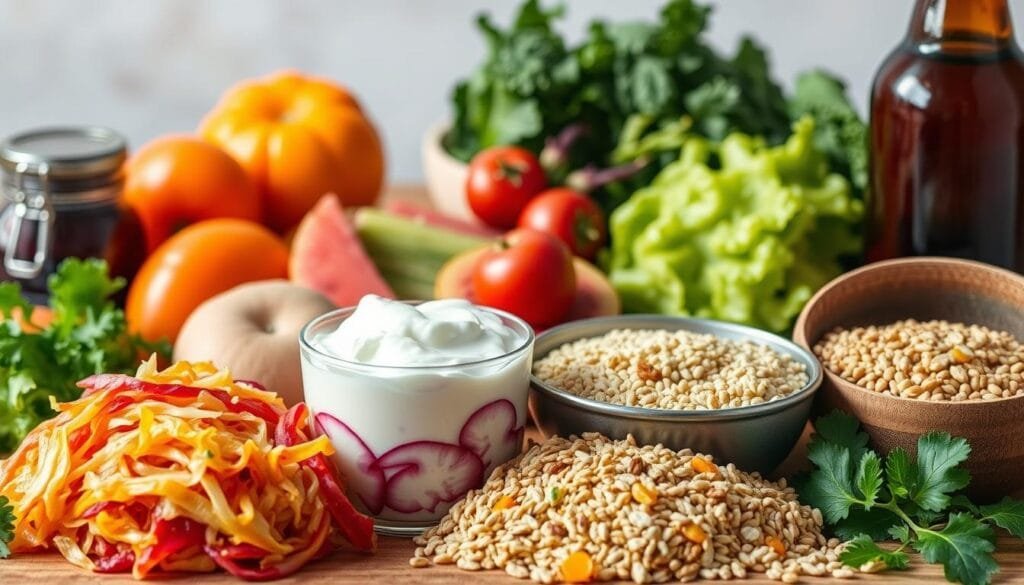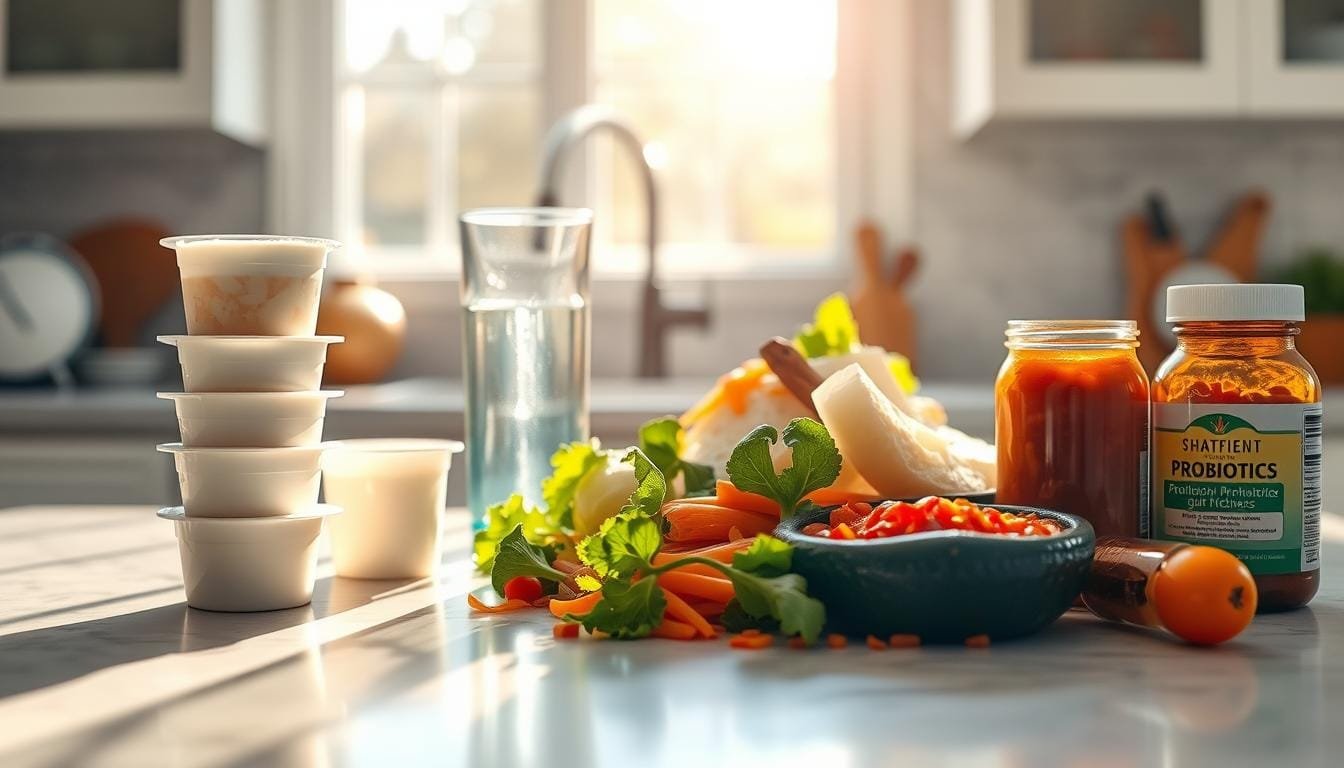Currently Empty: RM0.00
Surprising fact: A single course of antibiotics can cut some gut microbes by up to 30%, changing digestion and mood for weeks.
Their impact can lead to common side effects like diarrhea and discomfort. This short guide explains practical steps that fit Malaysian routines and tastes.
Readers learn which fermented and prebiotic foods support the gut microbiome, when to take probiotics, and simple spacing tips that lower the risk of upset stomach during treatment. Emphasis shifts to high-fiber meals after the course to speed recovery.
Local options such as tempeh, yogurt drinks, kimchi, and brown rice make it easy to protect gut health without extra fuss. For tailored advice in Malaysia, message Wellness Concept on WhatsApp at +60123822655 during business hours.
Key Takeaways
- Antibiotics can disrupt normal gut microbes and cause side effects like diarrhea.
- Fermented and prebiotic foods help preserve and restore the gut microbiome.
- Space probiotics a few hours from antibiotic doses to improve survival of live cultures.
- A high-fiber focus after treatment supports recovery and overall health.
- Avoid grapefruit, pomelo, and certain calcium-rich juices with some antibiotics.
- Contact Wellness Concept on WhatsApp for personalized guidance in Malaysia.
Why supporting your gut matters during antibiotic treatment
Antibiotics target harmful microbes but can also reduce helpful populations in the digestive tract.
These medicines are vital for treating bacterial infections, yet they may change the gut microbiome. Even a short course can shift species in the gut and raise the risk of diarrhea or appetite changes.
When the microbiome is disrupted, the digestive tract may feel sensitive. People can notice queasiness, loose stools, or altered digestion because balanced gut communities help nutrient breakdown and immune defence.
Eating minimally processed whole foods that contain natural fibers, vitamins, and minerals supports recovery. Foods that feed diverse microbes help stabilise digestion and shorten the bounce-back time after treatment.
- Different types of antibiotics vary in breadth, but most influence gut balance to some degree.
- Simple dietary choices can ease side effects without affecting the medication’s effectiveness against infection.
- Doctors sometimes recommend probiotics to reduce antibiotic-associated diarrhea, depending on individual needs.
If gut-related side effects feel disruptive during clinic hours in Malaysia, contact Wellness Concept via WhatsApp at +60123822655 for support.
How do you get good bacteria while on antibiotics?
Practical steps — from spacing supplements to adding fermented dishes — support microbial balance.

Use probiotics wisely: strains, doses, and timing
Choose a quality probiotic and take it a few hours after each antibiotic dose. Many clinicians advise a 2–6 hours gap so live cultures survive better.
Probiotics may reduce antibiotic-associated diarrhea and help restore beneficial bacteria levels after treatment.
Lean on fermented foods
Include items with live cultures, such as yogurt, kefir, tempeh, kimchi, and sauerkraut. Look for labels saying “live and active cultures.”
Feed the gut with prebiotic foods and polyphenols
Prebiotic foods like oats, onions, garlic, and bananas help friendly strains grow. Cocoa and other polyphenol-rich choices boost Lactobacillus and Bifidobacteria growth.
Don’t overlook vitamin K-rich greens
Antibiotics can lower bacteria that help make vitamin K. Add kale, spinach, collards, or parsley to meals to support healthy levels in the body.
- Space supplements a few hours from medication.
- Choose fermented items that actually contain live cultures.
- Combine prebiotic and polyphenol foods to support growth and balance.
- Consult a professional about specific strains and doses if side effects recur.
For tailored probiotic selection and timing in Malaysia, contact Wellness Concept via WhatsApp at +60123822655 during business hours.
What to eat during your course versus after you finish
A gentle eating plan helps the body tolerate medication and supports recovery.
Gentle choices during the course
Keep meals plain and easy to digest.
Focus on rice porridge, soft eggs, steamed fish, tofu, ripe bananas, and clear broths. These foods are kind to the stomach when taking antibiotics and lower the chance of upset.
Keep high-fiber items modest so they do not slow drug absorption.
What to add after finishing
Increase fiber to encourage microbial growth.
After the course, bring back brown rice, oats, beans, lentils, and lots of vegetables. Spread fiber across the day to feed gut bacteria without overwhelming digestion.
Malaysian-friendly practical picks
Include yogurt drinks, tempeh, kimchi, simple miso soups, and leafy greens like kangkong or spinach for familiar flavors that support diet and health.
| Stage | Recommended foods | Why it helps |
|---|---|---|
| During the course | Rice porridge, steamed fish, tofu, ripe banana, clear broth | Easy digestion; modest fiber to protect absorption |
| Immediately after | Brown rice, oats, beans, lentils, leafy greens | Provides prebiotic fiber to restore gut bacteria |
| Ongoing | Yogurt drinks, tempeh, kimchi, miso soup | Adds fermented foods and live cultures for steady recovery |
For culturally tailored meal ideas in Malaysia, message Wellness Concept on WhatsApp at +60123822655 during business hours.
Foods and habits that can reduce antibiotic effectiveness
Some everyday foods and habits can change how certain medicines are processed in the gut. Knowing which items to avoid helps keep an antibiotic working as intended and reduces unexpected side effects.

Grapefruit and pomelo products
Grapefruit or pomelo juices inhibit intestinal CYP3A4. This can alter medication breakdown and reduce intended effects. Avoid these juices and fruit products while taking sensitive doses.
Calcium, fortified drinks and dairy timing
High-dose calcium supplements and calcium-fortified juices can bind some antibiotic types, lowering absorption. Space dairy, milk or yogurt about three hours from sensitive doses rather than removing them completely.
Alcohol and certain drugs
Avoid alcohol with metronidazole or tinidazole. Serious reactions can occur and may last 48–72 hours after the last dose. When in doubt, skip alcohol during treatment and the recommended waiting period.
Fiber and meal timing
Very high-fiber meals slow gastric emptying and may delay absorption. Keep large fiber pushes for after the course and keep meals modest during therapy.
| Risk | What to avoid | Practical tip |
|---|---|---|
| Altered drug breakdown | Grapefruit, pomelo | Avoid juices and concentrated products |
| Reduced absorption | High-dose calcium, fortified juices | Space supplements and fortified drinks from doses |
| Severe reactions | Alcohol with metronidazole/tinidazole | Stop alcohol during treatment and 48–72 hours after |
If unsure about interactions with a prescribed antibiotic, Malaysians can message Wellness Concept on WhatsApp at +60123822655 during business hours for general guidance.
Build a simple, safe gut-friendly routine
Small timing tweaks for doses and meals can support digestive balance through treatment. A steady plan reduces stress and makes it easier to include fermented foods and a probiotic when helpful.
A sample day: spacing doses, meals, probiotics, and fermented foods
Take the prescribed dose at the scheduled time. Wait a few hours, then take a probiotic supplement with a light meal that includes a small serving of fermented foods.
- Keep meals simple during therapy; save high-fiber plates for after the final dose.
- Use a phone reminder to track doses, meals, and supplement timing.
- Stay hydrated and avoid alcohol to protect overall health.
Supplement smarts: when a probiotic may help antibiotic treatment
Some clinicians recommend probiotics because evidence shows they can reduce antibiotic-associated diarrhea in many cases. Take probiotics a few hours after antibiotics to improve survival of live cultures.
Personalized guidance in Malaysia
For tailored timing, brands, and meal ideas in Malaysia, message Wellness Concept on WhatsApp at +60123822655. Business hours: Monday–Friday 9:30 am–6:30 pm; Saturday 10 am–5 pm; Sunday Closed.
When to seek professional advice
Serious side effects require timely assessment to avoid complications and to adjust treatment.
If diarrhea is severe, bloody, or lasts more than a couple of days during therapy, they should seek help promptly. This can signal a need to change the prescribed regimen or to add targeted care for infections of the gut tract.
If persistent side effects such as abdominal pain, rash, or dizziness appear—especially when several medications are in use—contact a clinician. Alcohol is contraindicated with metronidazole and tinidazole and must be avoided for 48–72 hours after the last dose.
Key reasons to get help
- Diarrhea is severe, bloody, or prolonged beyond a few days during taking antibiotics.
- New or ongoing side effects that affect daily health or that occur with multiple medications.
- Chronic infections, inflammatory bowel conditions, or prior tract issues that complicate recovery.
- Uncertainty about adding foods or supplements that might interact with treatment.
- Emergency signs: high fever, severe allergic reaction, or dehydration from ongoing diarrhea—seek urgent care immediately.
| Concern | What to report | Action |
|---|---|---|
| Severe diarrhea | Bloody stools, fever, dehydration | Contact clinic; may need a change in treatment |
| Multiple medications | New dizziness, rash, or worsening symptoms | Review for interactions and adjust medications |
| Diet or supplements | Grapefruit/pomelo, high-dose calcium, alcohol | Ask before adding foods or supplements |
Malaysians can message Wellness Concept on WhatsApp at +60123822655 during business hours: Mon–Fri 9:30 am–6:30 pm; Sat 10 am–5 pm; Sun Closed for tailored advice about antibiotics, interactions, and follow-up care.
Conclusion
Small, consistent habits—timing meals, spacing supplements, and choosing fermented foods—make a big difference for gut health.
After a course of antibiotics, restore the gut microbiome with varied whole foods, live-culture fermented choices, and prebiotic foods that feed growth. Leafy greens and cocoa polyphenols help support beneficial bacteria and micronutrient content.
Watch interactions: avoid grapefruit or pomelo, space high-dose calcium and dairy from medication by about three hours, and skip alcohol with metronidazole or tinidazole to reduce side effects.
Balance is practical—gentle meals during treatment, a fiber-forward diet afterward, and targeted probiotics when appropriate can rebuild levels of resilient gut bacteria.
For a customized plan that fits Malaysian diets and schedules, WhatsApp Wellness Concept at +60123822655, business hours Mon–Fri 9:30 am–6:30 pm; Sat 10 am–5 pm; Sun Closed.
FAQ
How can someone support their gut during a course of antibiotics?
They can take a targeted probiotic several hours after each antibiotic dose, choose fermented foods such as yogurt, kefir, tempeh, kimchi, or sauerkraut, and include prebiotic-rich choices like oats, onions, garlic, and bananas. Spacing probiotic supplements two to three hours apart from antibiotics helps strains survive. Light, minimally processed meals reduce stomach upset during treatment.
Why does supporting the gut microbiome matter during antibiotic treatment?
Antibiotics reduce both harmful and beneficial microbes, which can cause diarrhea, bloating, and reduced colonization resistance. Maintaining beneficial microbes and supplying fermentable fiber and polyphenols speeds recovery of a balanced microbiome and lowers the risk of antibiotic-associated side effects.
Which probiotic strains, doses, and timing work best with antibiotics?
Look for Lactobacillus rhamnosus GG, Saccharomyces boulardii, and certain Bifidobacterium strains. Typical doses range from 5–20 billion CFU for bacterial probiotics; S. boulardii is often 250–500 mg daily. Take supplements a few hours after each antibiotic dose and continue for at least one to two weeks after finishing the course to help reestablish levels.
What fermented foods are safe and helpful during antibiotic use?
Plain yogurt with live cultures, kefir, tempeh, miso, kimchi, and sauerkraut provide live microbes and supportive nutrients. Choose low-salt, minimally processed versions. Fermented drinks common in Malaysia, such as yogurt-based beverages and tempeh dishes, are convenient options.
What prebiotic foods and polyphenol sources should be included?
Oats, onions, garlic, leeks, asparagus, bananas, and cooked cooled potatoes supply resistant starch and inulin-type prebiotics. Cocoa, berries, and green tea offer polyphenols that favor beneficial microbes. Add these gradually to avoid excess gas.
Should vitamin K–rich greens be included during antibiotic therapy?
Yes. Leafy greens like kale, spinach, and collard greens provide vitamin K that some antibiotics may affect indirectly. Including these supports overall nutrient balance and vascular health during and after treatment.
What should the diet look like during the course versus after finishing antibiotics?
During the course, focus on gentle, easy-to-digest meals: broths, steamed vegetables, plain rice, yogurt, and cooked fruits. After finishing, increase diverse fiber, whole grains, legumes, and a wider variety of fermented foods to encourage microbial regrowth and resilience.
Which local Malaysian foods fit well into a gut-friendly plan?
Tempeh, miso soups, plain yogurt drinks, kimchi-style condiments, brown rice, and leafy greens are good picks. These fit local tastes and help restore microbial diversity when combined with prebiotic staples like bananas and onions.
Which foods and habits can reduce antibiotic effectiveness or cause interactions?
Grapefruit and pomelo products can alter drug metabolism for some medications. High-dose calcium supplements and certain fortified juices may bind specific antibiotics; space dairy at least three hours apart from doses. Alcohol should be avoided with metronidazole or tinidazole. Very high-fiber meals at dosing time can slow absorption, so save heavy fiber for after the course when appropriate.
What is a simple daily routine to support gut health during antibiotic therapy?
A sample day spaces antibiotic doses and probiotic supplements by a few hours, includes fermented food at one meal, and adds a prebiotic-rich side such as oats or a banana. Drink water, avoid alcohol if contraindicated, and keep meals simple to limit gastrointestinal upset.
When should someone consider a probiotic supplement for antibiotic-associated diarrhea?
If mild diarrhea appears, a probiotic like Lactobacillus rhamnosus GG or Saccharomyces boulardii can reduce severity and duration. Those with greater risk factors—older age, recent hospitalization, or multiple antibiotics—may benefit from proactive supplementation after consulting a clinician.
When is professional advice necessary for side effects or interactions?
Seek tailored support if severe diarrhea, blood in stool, high fever, persistent side effects, or multiple medications occur. For personalized guidance in Malaysia, contact Wellness Concept on WhatsApp at +60123822655 during business hours: Mon–Fri 9:30 am–6:30 pm, Sat 10 am–5 pm.



